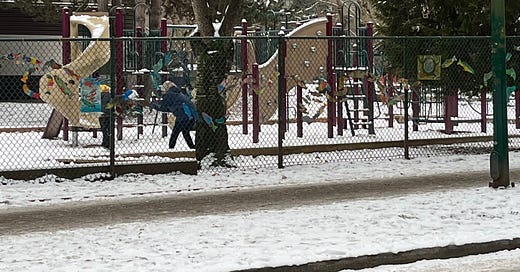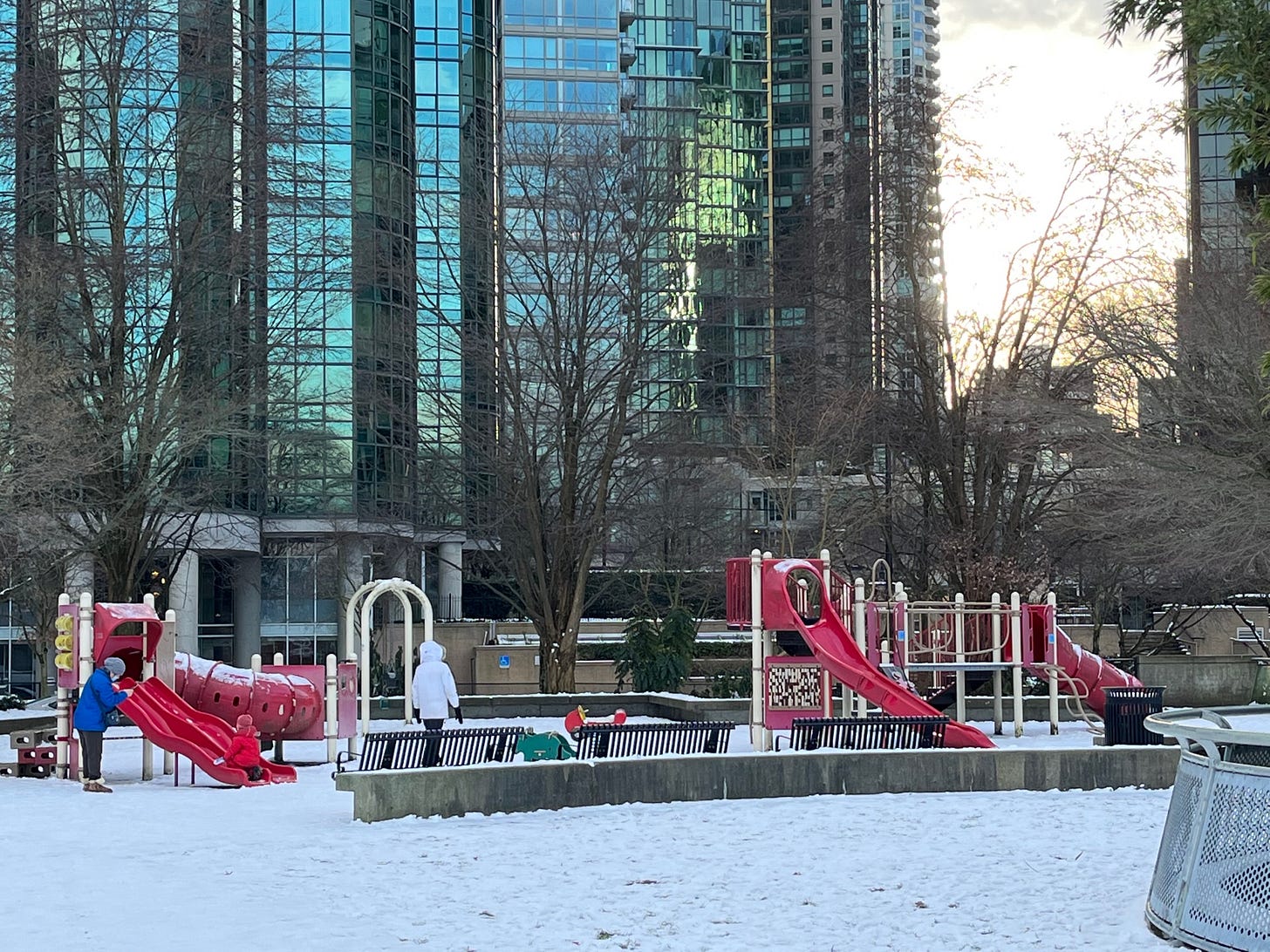Greetings, Unschool Writers!
Years ago I read about some research with children and fences.
I frequently think about this—the fences—when it comes to writing. That is, choices about writing forms, poetry, and all sorts of life bits. I also think about this when people speak about “getting out of the box,” as if box-escaping is a prize.
Now getting “outside the box” is seen as something beyond “positive.” It’s what we’re supposed to be doing, if we consider ourselves to be creatives, or if that’s how others see us.
But if we don’t understand the nature of a box, it can be many things.
What about those refrigerator boxes we played in as children—those boxes that could be cabin, fort, spaceship, castle…? What about the smaller boxes, when we curled up inside, and a big sibling closed the flaps, and it went dark? I digress…
The study
A group of children were given a natural space to play with a building—perhaps a home or school or park building—situated in the centre.
There were trees for climbing and bushes for hiding-and-seeking. Maybe there were flowers or tomatoes growing. Maybe there was a hill or two for sledding. A set of swings. A path meandering.
There was no fence.
The children were told they could play anywhere they wished, and left to do that. What did they do?
They stayed close to the building; they did not venture out to the trees and natural play-spaces. They most certainly did not wander down the paths or hills.
Part two of the study
A fence was erected to outline the perimeter of the property, a tall and secure fence. Nothing else was changed. The children were—again—told to play wherever they liked so long as they stayed within the fence.
This time, the children explored every inch of the property, climbed every tree, created games, explored paths. They went to the farthest reaches of the property, to everything that was enclosed within the fence.
There was a sense of safety, not from the proximity of building “home,” but from the parameters of the fence. The boundaries.
This is how a good box works.
Takeaways
The most obvious might be that wonder of going to the edges, once the edges are defined.
We “define edges” in other areas of our life, so why do we resist? We know our bank account balance before we go on vacation or buy a home. We know how much gas is in our tank as we set out across Death Valley. We know where the edge of the bed is so as not to fall off.
We need edges in some ways.
Another takeaway, or point-to-ponder: “home” is nice but—creatively—a fence is better. A fence invites us to venture away, and allows a certain freedom.
To ponder: what is your “home” and what is your “fence”? When does “fence” become “home”? (Thanks to B. for this last question.) What’s a new fence for you?
Yes, perhaps another post could look at those who—successfully—climb over the fence, and what that is about when done with a rope ladder and a few other supplies (compass and a snack). We can name books that strike us as being products of such “climbing over.”
But, much like the post on outlining, let’s start with knowing our fence/box. Knowing every inch of what is going on within, and what we can do with it. (Maybe we’ll even find a gate or two. What’s the difference between a gate and a ladder/rope to climb over?)
We’ve been having some discussion of what we’d like to work on in the coming year in the discussion thread posted over the break. You might add to it.
Either/or
“The test of a first-rate intelligence is the ability to hold two opposing ideas in mind at the same time…” ~~ F. Scott Fitzgerald
While I love this quote in its entirety, this first part resonates here and now.
The “two opposing ideas” here are to expand/explore or to constrict with what is referred to as “constrained writing.”
As writers we move in and out of both of these. To think about both states, and push ourselves in either direction, to be able to recognize what this means to our work and the results of what we create, is part of our process.
So much talk about “binary” thinking… but this work of holding two opposing ideas simultaneously is significant—it becomes both/and, while still recognizing when we need to fully immerse in one end or the other, and how we might be mindful of where we’re at. We might want to start without a fence in the early stages of a project, just letting all possibilities drift into our opened windows. (Here, I’m thinking of those stories about the Belgian trappist monks, and their beer-making process. We should have one of those to go with the compass and snack…)
And then—with awareness—create our fence, select the boards, build it. (The decision or realization that your story idea is in fact ideal as a screenplay, or as a picturebook, is such fence-building. Your main character is a boy of eight, or an ageing woman of eighty-two, is more fence-building. Your setting? Well, they call a stage’s “box-set” box for good reason. (We’ll explore this further in the next couple of weeks with the posts on world-building.)
Again, with awareness of when to hold on to our knowledge and when to let our minds and restrictions GO.
You might, in these early months of a new year, decide to go in the direction in which you are least accustomed. If the box is your usual place, get out. If out, get in. If you’ve actively been working in both directions, then feel out what is the middle-ground—how to bring together those “two opposing ideas.”
Prompt
For this month’s prompt, name your fences for a current project. (And write about them in your process journal.)
As an example, for a current project, some of my fences would be: 1526 (the year—I cannot think beyond that time-frame); Cheapside, London—Honeylane area (note: this narrowing, right down to maps/distances, is useful); the life of an 11 year old girl with a chronically-ill father, and working mother; responsible for care-giving; beginning to learn to read in a time when girls did not (father, who used to be a printer, teaching her); max 200 pages for this age group. I’ll find and build more as I go. More fences eases the writing.
December posts — summaries
The number of posts was a bit lower than usual as I did take a needed break. I also spent substantial time digging into material on “outlining.” That’s the first post I’ve written where up popped Substack’s warning that I was close the max word count—I didn’t know such a thing existed. Thank you for adding your thoughts and experiences, and discussing. This is when The Unschool gets interesting—hearing your words! I wonder if anyone created a chart such as the one posted in the piece, and how that process worked… (Share in the comments at cose of the post.)
I posted a “business” piece on what to do when you include others’ song lyrics in your work—and the copyright question. That piece concluded with examples from the process of finding the right lyrics for a picturebook of mine, Grandpa’s Music, and working together with an editor at Albert Whitman & Co.
A third “close read” piece looked at Zadie Smith’s On Beauty, and her dialogue in particular. This circled back to November’s piece on dialogue. This connecting of ideas and elements is feeling organic, feeling “unschool.”
Given the busy-ness of December, I had to post about writing through such times.
The newsletter for December featured three lovely chickens (!) and a prompt for “found-story” prompts. The subsequently posted prompt thread inspired a few stories, and one had to be posted separately with its visual.
I’m happy to say that Substack is working on a way for us to be able to post images in comments. And yes, they have added an “edit” capacity for comments now, too. They really are responsive to requests! It was good to have these stories posted, and the mini-course stories and poems that continued from earlier in the fall (paid subscribers only) was altogether enlivening! Thank you. I am planning on another mini-course/workshop in the near future.
Do not hesitate to re-visit any of the monthly prompts, and write and post for feedback. Use the Index to find these.
And of course, a closing-off-for-holidays piece that kicked off discussion threads for the last days of the month.
~~~
Substack shared The Unschool in a post on newsletters focused on writing, and close to a hundred writers subscribed! Many have been reading, catching up on posts. (Yes, I can tell—there are five little stars that fill with yellow as you read. And that’s been good to see, to know you are getting something out of all this!)
Please let me know if you have any writing-related questions, either in the comments or via email: alison@alisonacheson.com.
I look forward to hearing from you, and here we go into 2022.
I’m adding hours to my December bursary offer (on the honour system—use it if you need it!) It’ll be 22% off until January 2. (Canadian funds…so approx. $37 US)
I offer such bursary only once a year, so it’ll be back to the usual price soon. But to kick off the New Year, here it is:
Regular subscription: (about $47 US)
And please share The Unschool with other writers:
I can’t make this happen without the support of paying readers—I am profoundly grateful for your support!
Peace—
Alison





